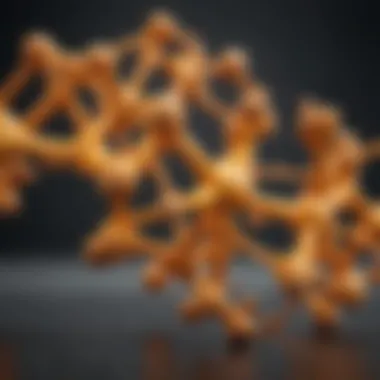The Most Absorbable Curcumin: An In-Depth Analysis


Intro
Curcumin, the principal active component of turmeric, has gained popular attention for its therapeutic properties. However, despite its potential, curcumin's bioavailability remains a critical issue. Understanding how various formulations enhance absorption is essential for both health practitioners and individuals seeking to harness its benefits. This section provides an overview of curcumin's characteristics and the importance of its absorptive capacity in the context of health and wellness.
Key Findings
Major Results
Recent studies underscore that not all curcumin formulations are created equal when it comes to absorption. Various methods have been identified to improve the bioavailability, which can significantly enhance therapeutic outcomes. Here are some notable findings:
- Nanoparticle Formulations: Research has demonstrated that curcumin nanoparticles can improve absorption levels in the body, allowing for more efficient delivery to target sites.
- Phospholipid Complexes: When curcumin is combined with phospholipids, it creates a liposomal structure that can be better absorbed by the body.
- Black Pepper Extract (Piperine): This common spice has been shown to increase curcumin absorption by up to 2000%. Combining curcumin with piperine is a widely recognized method to enhance its effectiveness.
These findings highlight the diverse avenues through which curcumin’s bioavailability can be improved, opening doors for more effective health management strategies.
Discussion of Findings
The quest for the most absorbable curcumin has led to innovative research and product development. The implications of better absorption extend beyond individual health benefits, impacting public health as a whole. For instance, enhanced bioavailability contributes to improved efficacy in managing various conditions such as inflammation, chronic pain, and digestive issues. Moreover, the growing interest in turmeric supplements reflects a broader shift toward natural alternatives in health care.
"Understanding the mechanisms that enhance curcumin absorption is paramount for maximizing its therapeutic potential."
Methodology
Research Design
The investigation into curcumin formulations involved a combination of quantitative and qualitative analyses. Various studies were reviewed to evaluate how different formulations affect absorption rates and therapeutic outcomes.
Data Collection Methods
- Clinical Trials: Several double-blind studies assessed the bioavailability of different curcumin formulations. These trials provided a robust dataset to evaluate efficacy and safety.
- Laboratory Experiments: In vitro experiments were employed to study how curcumin interacts with various compounds to enhance absorption.
- Meta-Analyses: Aggregated data from multiple studies helped form a comprehensive understanding of curcumin's bioavailability across different contexts and formulations.
The methodologies employed ensure a thorough understanding of curcumin's effectiveness and its absorption-enhancing mechanisms.
Preamble to Curcumin
Curcumin is a compound that has gained substantial attention for its potential health benefits. Found in turmeric, it has been used for centuries in traditional medicine. Knowing about curcumin’s properties is vital for anyone serious about health and wellness. The interest in curcumin is not just due to its culinary uses but also its pharmacological implications. Understanding curcumin can help us in leveraging its benefits more effectively.
Curcumin's relevance stems from its bioactive nature, which implies it has effects on the body, impacting inflammation, oxidative stress, and even mood. For students, researchers, or professionals, comprehending the basics of curcumin paves the way for more advanced studies on dietary supplements and natural therapies.
Definition and Chemical Structure
Curcumin belongs to a class of compounds known as curcuminoids, which are responsible for the yellow color of turmeric. Its chemical formula is C210O6, indicating it consists of carbon, hydrogen, and oxygen atoms. Structurally, curcumin is a diketone, characterized by the presence of two ketone groups that contribute to its distinctive properties. The chemical stability of curcumin plays a crucial role in its absorption and effectiveness.
Understanding the chemical structure of curcumin offers insights into how this compound interacts with various biological systems in the body. The molecular configuration allows curcumin to bind effectively with specific proteins and enzymes, which enhances its therapeutic potential. However, this same structure also leads to challenges in bioavailability, limiting the extent to which curcumin can exert its effects in the body.
Historical Uses of Curcumin
Historically, curcumin has been a staple in Ayurvedic and Chinese medicine. Ancient texts reference its use for a wide array of ailments, from digestive disorders to skin conditions. Its anti-inflammatory properties were particularly valued in ancient healing practices. In the context of traditional remedies, curcumin was often combined with other herbs to enhance its efficacy.
Aside from its medicinal uses, curcumin has played a role in cultural practices, such as religious ceremonies and dietary rituals, especially in the Indian subcontinent. Its significance has transcended generations, highlighting the deep-rooted respect for turmeric in many cultures. Today, the historical context of curcumin provides a foundation for its modern applications, informing current research trends and the exploration of its health benefits.


"Understanding the historical context of curcumin enriches our appreciation for its modern applications in health and wellness."
In summary, the significance of curcumin cannot be understated. As we transition deeper into the exploration of its absorption and bioavailability, it is crucial to grasp these foundational concepts. By recognizing curcumin's chemical structure and historical uses, we can better appreciate its role in therapeutic practices.
Importance of Bioavailability
Bioavailability is a critical concept in pharmacology and nutrition, especially concerning curcumin from turmeric. In this article, understanding bioavailability helps explain why curcumin’s effectiveness can vary greatly. When considering therapeutic compounds, it is the bioavailability that determines how much of the substance actually reaches systemic circulation in the body. This significantly influences the potential health benefits.
Key elements of bioavailability include:
- Absorption: This refers to how well a substance enters the bloodstream after administration.
- Distribution: This involves how the substance disperses to various tissues once in circulation.
- Metabolism and Excretion: These processes affect how long the compound remains active in the body and how it is eliminated.
For curcumin, its low bioavailability means that large doses are often required to achieve desired effects. This can lead to unwanted side effects or reduced efficacy in treating various health conditions. Thus, exploring methods to enhance bioavailability is crucial for maximizing curcumin's therapeutic potential.
Understanding Bioavailability
Bioavailability reflects the proportion of a nutrient or bioactive compound that can be absorbed and utilized by the body. For curcumin, this metric is especially low when ingested in its natural form. Factors such as solubility and the presence of other compounds can either enhance or inhibit its uptake in the body.
The low bioavailability of curcumin has led many researchers to explore innovative formulations that significantly increase its absorption. For instance, formulations that combine curcumin with fats can improve solubility and thus bioavailability. In contexts where health outcomes are essential, analyzing bioavailability can aid in formulating effective dietary supplements and pharmaceuticals.
Factors Affecting Bioavailability
Numerous factors can influence the bioavailability of curcumin. These include:
- Formulation Type: The way curcumin is prepared plays a vital role. Liposomal and microemulsion formulations allow greater absorption compared to plain powder.
- Food Matrix: The presence of other nutrients or compounds, like fats, can improve the absorption of curcumin. A meal containing healthy fats could enhance its bioavailability.
- Metabolic Pathways: The metabolic response within the liver significantly impacts how curcumin is processed and how long it remains in circulation.
- Digestive Health: Individual gastrointestinal health, including factors like motility and microbiome composition, can drastically alter absorption rates of curcumin.
The understanding that bioavailability is not just a simple measurement but a factor that encompasses many variables is vital for curcumin's effective use.
Optimizing bioavailability is an essential step in harnessing the therapeutic benefits of curcumin. Without addressing these factors, the outsized potential of curcumin may remain largely untapped.
Challenges with Curcumin Absorption
Curcumin, despite its well-documented benefits, faces significant challenges in absorption when consumed as a dietary supplement. Addressing these challenges is crucial not only for maximizing its therapeutic effects but also for enhancing the overall effectiveness of nutritional strategies aimed at improving health outcomes. Understanding these hurdles provides valuable insights for researchers, healthcare professionals, and consumers alike.
Low Water Solubility
One of the primary issues with curcumin absorption is its low water solubility. Curcumin's hydrophobic nature means it does not dissolve well in water, which significantly limits its availability in the digestive tract. When ingested, curcumin tends to aggregate, and hence, its interaction with enzymes and intestinal cells is reduced. This aggregation leads to lower systemic concentrations of the compound, limiting the effective doses that can reach the bloodstream.
To overcome this barrier, various formulation strategies have been developed. For instance, using novel technologies such as liposomes or microemulsions can enhance the solubility of curcumin in water, promoting better absorption. Additionally, combining curcumin with substances like phospholipids or surfactants can substantially increase its absorption rate and overall bioavailability.
Rapid Metabolism in the Liver
Another significant challenge is the rapid metabolism of curcumin in the liver, which further complicates its bioavailability. After curcumin enters the bloodstream, it undergoes first-pass metabolism, a process where a substantial portion of the compound is metabolized before it can exert therapeutic effects. This rapid processing often leads to the production of various metabolites, some of which may be inactive or less effective than curcumin itself. As a result, the concentration of curcumin that reaches systemic circulation is markedly diminished, reducing its potential benefits.
The understanding of this metabolic pathway has spurred research into ways to mitigate first-pass metabolism. For example, co-administration of curcumin with certain bioenhancers like black pepper extract (which contains piperine) has shown promising results. Piperine can inhibit some metabolic enzymes, allowing curcumin to remain in its active form for longer periods. This approach not only helps in achieving improved therapeutic outcomes but also underscores the importance of strategic formulation in enhancing curcumin's overall efficacy.
"The enhancement of curcumin bioavailability is not only a scientific challenge but also a potential breakthrough in therapeutic applications."
By addressing the challenges of low water solubility and rapid metabolism, researchers can develop highly absorbable curcumin formulations that maximize the health benefits associated with this powerful compound. Such advancements will pave the way for more effective use of curcumin in clinical settings, ensuring that individuals can fully capitalize on its therapeutic potential.
Innovations in Curcumin Formulations


Innovations in curcumin formulations are crucial to enhancing the bioavailability and therapeutic effects of this promising compound. While curcumin itself has shown various health benefits, its natural properties limit its absorption in the human body. Traditional formulations often fail to deliver substantial levels of curcumin to target tissues. Therefore, advancements in the formulation of curcumin aim to overcome these challenges. This section delves into three notable innovations: liposomal curcumin, curcumin microemulsions, and curcumin with black pepper extract (piperine).
Liposomal Curcumin
Liposomal curcumin is a significant breakthrough in the quest for improved absorption. Liposomes are tiny spherical vesicles composed of phospholipids. They encapsulate curcumin molecules, protecting them from degradation in the gastrointestinal tract. This encapsulation allows for enhanced delivery of curcumin into the bloodstream. As a result, studies have shown that liposomal curcumin can increase bioavailability by several times compared to standard curcumin supplements.
One of the key benefits of liposomal formulations is that they can reduce the side effects often associated with curcumin, such as gastrointestinal discomfort. This makes liposomal curcumin a favorable option for individuals seeking therapeutic doses without the adverse effects. Ultimately, its ability to deliver curcumin effectively paves the way for better patient outcomes in various health conditions.
Curcumin Microemulsions
Microemulsions represent another innovative approach to curcumin absorption enhancement. These formulations comprise water, oil, and surfactants, creating a stable solution that allows curcumin to dissolve more readily. Microemulsions can significantly improve the solubility of curcumin, thus facilitating its absorption through the intestinal wall into the bloodstream.
Research indicates that microemulsion formulations can achieve higher plasma concentrations of curcumin with lower doses. It also offers the potential for prolonged release of curcumin, ensuring a longer-lasting effect in the body. This method of formulation is particularly interesting for pharmaceutical applications, where precise dosing is often required.
Curcumin with Black Pepper Extract (Piperine)
Combining curcumin with black pepper extract, which contains piperine, is another effective strategy to enhance absorption. Piperine is known to inhibit certain enzymes that metabolize curcumin, leading to higher curcumin levels in the blood. This combination reportedly increases the bioavailability of curcumin by up to 2000%.
It's essential to note that while this combination is widely recognized, individuals should consider dietary interactions. Some people may experience gastrointestinal issues with high doses of piperine. Therefore, it's advised to consult healthcare providers before starting a regimen that includes piperine.
The innovations in curcumin formulations demonstrate a commitment to improving health outcomes through science. Each method provides unique benefits, catering to different patient needs and health conditions. As research continues, these formulations will likely continue to evolve, offering even more effective ways to harness the healing potential of curcumin.
Clinical Applications of Highly Absorbable Curcumin
Curcumin has gained significant attention in recent years due to its various potential health benefits. This section will explore the clinical applications of highly absorbable curcumin, emphasizing its anti-inflammatory effects, antioxidant properties, and potential in cancer therapy. Understanding these applications is crucial as they directly relate to curcumin's bioavailability and its efficacy in therapeutic settings. The importance of these applications is rooted in the growing interest among researchers and healthcare practitioners in finding effective natural interventions for health promotion and disease management.
Anti-Inflammatory Effects
Curcumin is widely recognized for its anti-inflammatory properties. It acts on numerous biochemical pathways that mediate inflammation. Highly absorbable forms of curcumin can significantly enhance its effectiveness in managing chronic inflammatory conditions such as arthritis, inflammatory bowel disease, and other autoimmune disorders.
Research has shown that curcumin inhibits nuclear factor kappa B (NF-kB), a protein complex that plays a crucial role in controlling the transcription of DNA and thus regulating the immune response. By deactivating this factor, curcumin helps reduce the inflammatory response in the body.
- Chronic Pain Management: Due to its ability to lower inflammation, curcumin may be beneficial for individuals suffering from chronic pain syndromes.
- Joint Health: In conditions like osteoarthritis and rheumatoid arthritis, curcumin's action on inflammation can lead to improved joint function and mobility, offering patients a natural option to manage their symptoms.
Antioxidant Properties
Curcumin's antioxidant capabilities are well-documented and play a vital role in its therapeutic applications. This compound helps neutralize free radicals, which can cause oxidative stress leading to cell and tissue damage. By enhancing the body's antioxidant defenses, highly absorbable curcumin formulations may protect against various diseases linked to oxidative stress, including heart disease and neurodegenerative disorders.
Studies indicate that curcumin boosts the activity of the body's own antioxidant enzymes. This attribute is especially important since oxidative stress is often implicated in the aging process and the development of age-related diseases.
- Heart Health: Regular intake of curcumin may reduce the risk of cardiovascular diseases by diminishing oxidative damage to lipids and proteins in the bloodstream.
- Cognitive Function: There is ongoing research into curcumin's potential statements in preventing and treating neurodegenerative diseases like Alzheimer’s, where oxidative stress plays a critical role.
Potential in Cancer Therapy
One of the most promising areas of curcumin research is its potential use in cancer therapy. High absorbable curcumin can potentially inhibit cancer cell proliferation and induce apoptosis, or programmed cell death, in various cancer types. This effect is attributed to curcumin's ability to modulate multiple signaling pathways involved in tumor growth.
Studies suggest that curcumin can affect cell cycle regulation, inflammatory responses, and chemical signaling associated with cancer development.
- Combinational Therapy: Curcumin can be utilized alongside traditional cancer therapies to enhance their effectiveness and reduce side effects.
- Preventive Approach: Beyond treatment, curcumin may act as a preventive agent, potentially lowering the risk of cancer in individuals at high risk due to genetic factors or lifestyle choices.
Understanding Curcumin Dosage


Understanding the appropriate dosage of curcumin is crucial for maximizing its potential health benefits. Dosage can influence the effectiveness of curcumin formulations, and different health conditions may necessitate varying amounts. It is essential for consumers to be informed about recommended dosages, effectiveness linked to dosage levels, and potential risks associated with excessive consumption. Dosage also interacts with factors like bioavailability, which can determine how much of the compound actually enters circulation in the body.
Recommended Dosages for Varying Health Needs
The recommended dosage of curcumin can vary significantly based on the individual's health needs and the specific formulation used. Here are some key points to consider:
- General Health: For general health and wellness, doses ranging from 500 mg to 1,000 mg of curcumin per day may be beneficial. This amount supports various functions, including inflammation reduction and antioxidant protection.
- Chronic Inflammation: Higher doses, up to 2,000 mg per day, have been utilized in studies focusing on chronic inflammatory conditions. Such conditions include arthritis and inflammatory bowel diseases.
- Cancer Therapy: In research contexts, curcumin has been administered in doses exceeding 2,000 mg per day as an adjunctive treatment in cancer therapy. These doses are often managed under professional guidance owing to their potential impacts.
- Age and Medical Conditions: Individuals' health status, age, and existing medical conditions will also dictate dosage. Elderly individuals or those on medications should consult health practitioners for personalized recommendations.
Safety and Side Effects
Curcumin is generally considered safe when taken at recommended dosages. However, higher dosages increase the risk of side effects. Some potential side effects include:
- Gastrointestinal Distress: High doses may lead to nausea, diarrhea, or upset stomach, particularly in individuals not accustomed to curcumin.
- Blood Thinning Effects: Curcumin may have anticoagulant properties, which can be a concern for individuals on blood-thinning medications such as warfarin.
- Interactions with Medications: Curcumin may interact with various medications, such as nonsteroidal anti-inflammatory drugs (NSAIDs) or certain chemotherapy agents. Consulting a healthcare provider is essential if you are on medication.
Overall, while curcumin has many benefits, it’s vital to adhere to recommended dosages. Before integrating curcumin into any health regimen, individuals should consider both their health needs and the potential for side effects to achieve the best outcomes.
Curcumin Research Trends
Curcumin research trends represent a vital aspect of understanding the compound’s potential benefits and limitations. As more studies emerge, it becomes clear that the therapeutic possibilities of curcumin stretch far beyond its traditional use. Awareness about its bioavailability challenges paves the way for innovative formulations and applications. Researchers are continually investigating new delivery methods and health applications, making this field dynamic and significant.
The growing body of literature surrounding curcumin supports its potential in diverse therapeutic areas, including anti-inflammatory and anticancer properties. By closely examining these trends, we gain insight into how curcumin can be effectively utilized in modern healthcare, thus enhancing patient outcomes and promoting overall wellness.
Recent Studies and Findings
Recent studies have produced insightful findings regarding curcumin's effectiveness in various health conditions. For instance, clinical research points toward curcumin's ability to diminish inflammation markers, suggesting its potential in treating chronic inflammatory diseases. Research also highlights that curcumin can improve cognitive function in individuals with neurodegenerative diseases. These studies provide a promising outlook on its role in tackling significant health challenges.
Moreover, meta-analyses have confirmed the efficacy of curcumin in reducing symptoms of arthritis, showcasing its benefits in pain management. The incorporation of curcumin in clinical trials demonstrates increasing recognition of its health benefits, broadening its scope in therapeutic contexts.
"The evidence is compelling, supporting curcumin's role in health management."
The exploration of innovative formulations, such as liposomal curcumin and microemulsions, has gained attention. These advancements aim to address the low bioavailability issue, leading to improved absorption. Recent evidence suggests that these new forms significantly enhance curcumin’s therapeutic potential.
Future Directions in Curcumin Research
Looking forward, future directions in curcumin research are promising and multi-faceted. One crucial area of exploration is the investigation of tailored curcumin formulations designed for specific patient populations. Personalized medicine can unveil how curcumin’s efficacy varies with genetic or metabolic factors, ensuring customized healthcare solutions.
There is also a need for more large-scale randomized controlled trials to validate the clinical effectiveness of curcumin. These studies should focus on its long-term safety and bioavailability in different populations. Collaboration between researchers, universities, and industries will be essential in shaping this future.
Exploring combining curcumin with other natural compounds is another avenue for future research. Enhancing its absorption and bioavailability, potentially through synergistic effects, could open new therapeutic applications.
The End
The convergence of research on curcumin’s bioavailability and the development of innovative formulations presents a promising landscape for its therapeutic applications. This article underscores the significance of understanding curcumin's absorbability, which is crucial for harnessing its medicinal properties effectively. The discussion emphasized several key formulations, such as liposomal and microemulsified curcumin, that enhance bioavailability. This is vital given that curcumin's potential benefits — ranging from anti-inflammatory effects to possible roles in cancer therapy — depend largely on how well the body can utilize it.
Moreover, the examination of dosage recommendations and safety considerations ensures that users can navigate their choices responsibly. It is clear that proper formulation can mitigate curcumin's inherent challenges, allowing for improved outcomes in health management. With ongoing research driving innovations, future formulations promise even more refined mechanisms to enhance absorption, leading to better therapeutic results for users.
Summary of Key Points
- Curcumin's Benefits: Curcumin is recognized for its anti-inflammatory and antioxidant properties, which lend themselves to various therapeutic roles.
- Bioavailability Challenges: The primary issue is curcumin's low solubility and rapid metabolism, limiting its efficacy in the body.
- Innovative Formulations: Recent advancements, such as liposomal curcumin and the addition of piperine, have significantly improved absorption rates.
- Clinical Applications: Enhanced curcumin formulations show promise in treating inflammatory conditions, oxidative stress, and potential cancer therapies.
- Future Research Directions: Continued exploration into curcumin's applications and new delivery methods remains crucial for maximizing its health benefits.
The Future of Curcumin Usage
The landscape for curcumin use is set to evolve with the integration of advanced research findings and formulation strategies. As more studies validate the effectiveness of highly absorbable curcumin, we can expect an increased adoption of these products among both practitioners and consumers.
Education on proper dosages and efficacy will likely improve, facilitating informed decision-making among users. Potential collaborations between researchers and manufacturers may yield novel formulations that address current limitations. Additionally, the exploration of curcumin’s roles in new therapeutic areas might emerge as a significant trend in both clinical settings and everyday wellness routines.
In summary, the future of curcumin usage holds substantial promise, defined by improved formulations and broader applications in health. Continuous research will further illuminate curcumin's capabilities, reshaping how we perceive and utilize this powerful compound.



